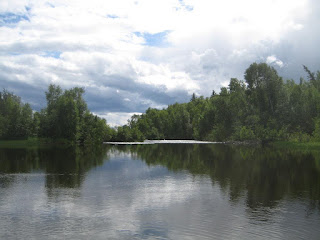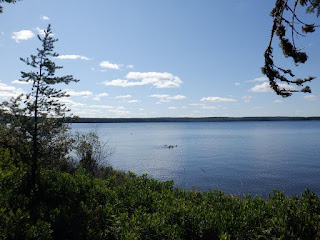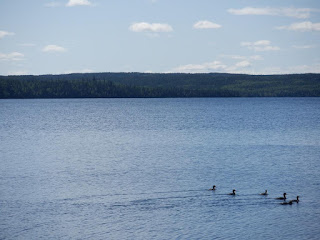July 27, 07:45 - 08:04 moving down the river after leaving camp 21. Very cloudy, strong smoke smell, smoke evident at the horizons.
11:06, canoe loaded after the 360 metre portage at the sixth rapids, class 4. The view behind me is across the base of the rapids.
The following photos of rapids were taken on my 2017 trip (where I cut a virgin portage across country to come out farther up the river than this year's trip, but the rapids and trails are in similar condition, just smoky now).
More photos of the sixth rapids.
Several class 1 rapids between the sixth and seventh major rapids. The rapids just below the sixth rapids are class 1+.
Seventh rapids, class 2+, run instead of taking the 300 metre portage.
Eighth rapids, class 1+, run instead of taking the 25 metre portage.
Ninth rapids, class 2+. I wade and lift over a ledge of the first part to take a 50 metre carry, instead of the longer 150 metre trail.
July 28, camp 22 on an island two km down the lake below the ninth rapids. The two barrels are placed to help anchor the front of the tent in the strong wind. The camp is 13 km from the previous location, plus I paddled an extra three km unsuccessfully searching for a site above the ninth rapids. In hindsight I should have camped right at the eighth rapids to fish on the river one last time for walleye.
A salad of orange northern comandra berries, blueberries, larger Saskatoon berries, green and partially ripe lingonberries, yellow goldenrod flowers, pink fireweed petals and a few seed pods, green raspberry leaves and new shoots.
July 28 at 10:01, a gorgeous sunny day, looking back two km to the ninth rapids emptying into the lake.
Six common mergansers near camp, the young flying well now as the season progresses.
**********************
Summary:
Encounter an animal on land at close range that might be a bear but proves to be a large otter. Heavy rain and strong wind make for a cold supper in the nylon tent. Catch two pike for fish chowder, one more than I would eat a month ago, but now 'I could eat a jackass stuffed with fireworks'. As the season progresses, young of the year are adult size and flying well. Camp 22 is 13 km from the previous location, plus paddling an extra three km unsuccessfully searching for a campsite above the ninth rapids. It is on an island two km down from the last rapids into the big lake. I run several class 1 rapids, two class 1+, one class 2+ and portage past two rapids (360 metres along a class 4, 50 metres around a class 2+), making my way down or past major rapids six to nine.
July 27:
Up at 03:30 to the alarm, it is still quite dark so I light a candle to pack gear. From my journal: "Brother Glen's birthday today. Open door (screen closed) to shed some light on the interior. It's quite gloomy, very cloudy and overcast. So much for any weather prediction on my part. Thunderstorm, poured heavy rain during night. Everything wet, underbrush soaked. C'est la vie. Very very cloudy, smoky, dead calm. Can smell smoke." After eating breakfast inside and packing the wet Tent and Tarp shelter, I am on my way. I run multiple class 1 rapids throughout the day, including two class 1+, plus a class 2+; I take the 360 metre portage past a class 4 rapid, and a 50 metre carry around another class 2+ rapid. Luckily the canoe ships very little water, mopping it up with a sponge. Arriving at 08:40 at the class 4 rapid, I finish the carry at 10:40, and move on again by 11:15. When I reach the first class 2+ rapid, I stop at the upper portage landing to check if it is safe to run. Going the entire length of the 300 metre trail, cleared with a chainsaw of many large down trees since 2017 when it was barely passable, I walk through the bush in several places to get a view of the entire rapids, deciding where I am going to manoeuvre the canoe. I always say out loud my plan in a repetitive mantra, in this case, "start centre, then left of the centre shoal close to the left side then move right, staying to the left of the right side lower rapids". (Below the shoal there are boulders in the middle of the lower rapids.) After paddling the second class 1+ rapid into a small unnamed lake, still part of the river system, I hope to camp nearby for walleye fishing. I end up paddling an extra three km on this lake searching for a good location, and in hindsight should have camped right at the rapids but was hoping for a camp on one of the several islands. The first spot I check is a small island just down from the rapids but it would be a hard luck camp, exploring it at both ends and the centre. Much of the island is densely covered with small spruce on rocky bouldery ground. I write: "At the lower end, I walk across a small open raised area and see a large patch of glossy dark fur on some kind of animal. First thought is a bear; what's he doing here?! Crouching down to peer through the thick trees I see it's a very large otter. He sees me, runs down the slope to the steep shore about five metres away through thick small spruce and jumps into the river. He was laying down, stretched out, when I first saw him. Awesome! Looking up close to see no evidence that he was eating a fish, I think he was resting and cleaning his fur. Don't know which of us was more startled. Glad it wasn't a bear." Paddling past lots of shoreline, I check three islands, all with some steep rock shores and very thick spruce and pine bush. Finally I give up and canoe minor rapids to reach the next major set, a class 2+ with a ledge across it. There is a 150 metre portage, but I investigate the upper portion of the rapids from several viewpoints and decide to take a shorter impromptu 50 metre carry across mostly bare rock. I startle a family of ruffed grouse, adult size, some flying well a short distance, most just running quickly away. Donning wading gear, I wade and lift over a ledge near shore of the first part of the rapids, then hop in the canoe to take the swift water around a point of brush-covered rock that juts out above the long ledge, paddling hard to then get into the eddy of a pool where I can tie up at the rock shore. It is easy to carry all the gear the short distance to the lakeshore beside the bottom of the rapids, including the barrels without harness. Now the packs in the bottom of the canoe are wet from the water of my wading gear, but I start the drying process by laying them on the bare rock as I unload the canoe. The afternoon has been sunny with lots of blue sky and white cumulus. From my journal: "Hear a loud bang of thunder behind me and turn to see large rolling clouds roiling at the edges like smoke, both intimidating and awesome. Canoe is already loaded but I take the time to get the medium tarp out to cover the gear." There is a strong headwind obvious in the waves of the lake and I have two km to go against it to the island where I camped in 2017. However, it is a wind-exposed site and I want to check other locations. The closest small island is not suitable so I continue on towards the other but head ½ km closer to the centre of the island and thicker bush with more protection. From a distance there is promising shoreline, not so when close up, not even worth stopping to check. So I capitulate and head to the old campsite, which is a nice fair-weather spot but wind-exposed from all directions, being near the long narrow tip of the island. Probably an equal reason for checking elsewhere is that in 2017 I had to clean up a lot of plastic garbage left by previous canoeists. Aie!
The sky is very menacing with dark clouds, now accompanied by thunder. After unloading and storing gear not needed under the canoe, I erect the Tarp shelter which barely fits in the best spot, as far away as possible from shores both in front and behind the site. While it starts to rain, I have to fell one medium-size spruce tree at the edge of the Tarp, after getting the upper rope in place which stretches the Tarp hard against the tree; laid out on the ground I thought the Tarp would fit. Getting wet in the rain driven by very strong onshore wind, I finish stringing the bottom anchor rope. I manage to get the gear under the Tarp before it really pours hard. Sitting on packs underneath, my head holds the Tarp up when the wind is sucking it down in between blowing it upwards with strong gusts. After half hour the storm passes on with just some rain remnants. Now I can clear the nylon tent site of fallen branches and trees, and get the tent up with all gear inside. I situate the two heavy barrels at the front corners of the tent to help protect against the wind. Having landed at 16:55, I know it must be late and in the continuing strong north wind and possibly more rain there is no way to have a fire to cook the meal of macaroni and cheese I was so looking forward to as a reward. From the Kitchen Barrel under the Tarp shelter on the mostly dry moss floor, the only such place in camp, I get out the food needed for a cold meal, wrapped in the 'tablecloth' tarp which I place in the tent. I have already tossed a big pile of gear into the tent, nothing laid out in any semblance of order (chair, encased gun, fly swatter, sleeping gear bag, pee bottle, canteen, Waist Pack, sleeping pad underlay, Rubber Pack, tent floor tarp). With Kitchen Barrel in the front vestibule, and all other gear in the rear, I crawl into the tent. After undressing, I get the floor tarp and sleep gear laid out. When my usual bedtime ablutions are complete, I don pajamas. I write: "Finally, supper ... hungry ... canteen water with tomorrow's breakfast for supper (seeds, quarter bannock, protein bar, peanut butter, plus supper protein bar and sardines). Could eat more but that feels a lot better. A few hours later my stomach is grumbling, digesting this late meal. Place garbage in doubled Ziploc® bags to burn tomorrow." I fold the medium tarp under the upper side of the sideways-sloped bed to level it, Rubber Pack beside my feet to keep me in position. In fleece shell by 20:30, I sleep well after a long busy day.
Camp 22 is 13 km from the previous location, plus paddling an extra three km unsuccessfully searching for a campsite above the ninth rapids. It is on an island two km down from the ninth rapids into a big lake. I ran several class 1 rapids, two class 1+, one class 2+ and portaged past two rapids (360 metres along a class 4, 50 metres around a class 2+), making my way down or past rapids six to nine.
July 28:
Up at 04:30, I am hungry, but first need to fish for supper. The still strong north wind blowing onshore at camp means no fishing there. Walking to leeward of the long point, I catch a 19 inch pike, then moving a short distance, another 22 incher. Cleaning the fish on the spot, I dice it for chowder, two cups worth, a big meal. Noticing goldenrod in bloom, I will come back later to pick a salad. After reinforcing the somewhat sheltered fireplace with taller rocks against wind, well up on shore but safe on bare rock, I start a fire to boil water. I need to refill both canteens, empty after saving enough to mix bannock, plus I need water to drink and to cook breakfast, which will be the remainder of last night's breakfast-for-supper (oriental noodles with Parmesan cheese). From my journal: "Between last night's breakfast-supper and this morning's supper-breakfast, we're even. The extra fish for supper will help. I think I've reached that point where 'I could eat a jackass stuffed with fireworks.'(anonymous, Hunt's Yachting Magazine, 1854)." Bringing all gear out of the tent, I lay out the packs wet on the outside on the bare rock and hang sleepgear on the clothesline. My boots and jeans are drying on me. By 10:25 there is lots of blue sky and white cumulus, a cool 16°C with a light wind which has switched to the side. Improved weather is welcome after a late cold supper in the tent last night with very strong north wind, heavy rain and thunderstorms. As I gather firewood, I clean up some plastic garbage left by canoeists, but not the volume there was in 2017, thank goodness. Picking up firewood I find the rubbish lightly buried underneath brush or moss. I say: "Aie! If you don't have a fire to burn garbage, pack it out! It's lighter now than when you carried it in full! Aie!" By noon it is a bit warmer, mostly clear with a moderate sidewind and occasional strong gusts, no sign of smoke. Thinking I should have a bath, camp is cooler now in shade and I put on my long shirt which had been drying on the clothesline, so I chicken out on getting in the cold lake. There is a spot where I could erect the canvas Tent, with two down tree roots exposing enough soil for the stove if needed; however, I plan to move on tomorrow to find a more sheltered location. By 15:35 I have done more chores: pick salad for supper, gather and saw firewood, aliquot next week's grub, put away the aired sleep gear and the now dry packs, pack fish gear and tools, check a small point farther along shore sheltered by bush (that proves to be unsuitable for a camp). Thinking I would only have a small salad of goldenrod flowers, but walking here and there, find seven different kinds of plants that make a plateful. It is now a gorgeous day, 21°C just a light breeze, so much different than yesterday. Dressed again after a bath, I do have to don the long shirt though. At 16:55 I eat supper of fish chowder, salad, protein bar and hot water ... mmm good! I was not sure if I could eat two fish, where one would have been enough a month ago, but not a problem. Finishing prepacking, I have an early bedtime, sleeping well.


































